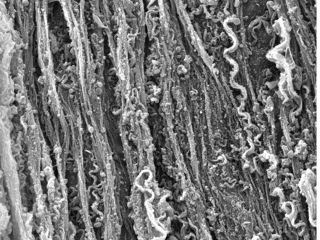Nov 28 2018
Is there anything greener than solar panels? They produce renewable energy, a crucial component to combating climate change. However, the components that are often added to them include poisonous or non-sustainable materials.
 The Dorval Lab has created conductive protein nanowires inspired by naturally occurring bacteria. (Image credit: McGill University)
The Dorval Lab has created conductive protein nanowires inspired by naturally occurring bacteria. (Image credit: McGill University)
Noémie-Manuelle Dorval Courchesne, a McGill University researcher, hopes to alter that. She is exploring the conductive properties of some naturally occurring proteins – a line of research that could one day lead to biological and biodegradable solar cells.
Nature is full of eco-friendly biological materials possessing properties that enable them to assemble into intricate shapes and bind particles or molecules. Progressively, researchers are attempting to replicate these processes—a field referred to as biomimicry—in order to develop green solutions to many ecological challenges.
“We’re trying to replicate what we can find in nature. I’ve always been interested in bio-derived materials,” says Dorval Courchesne, who grew up in Quebec’s Outaouais region and studied biotechnology at the University of Ottawa before earning her PhD at MIT. “In the past, I looked into using proteins or microorganisms to coat them with an inorganic layer that could be used to conduct electricity or harvest light. These inorganic particles, however, remain toxic, so during my postdoc (at Harvard’s Wyss Institute for Biologically Inspired Engineering), I began working on biological, environmentally friendly materials that could be conductive by themselves.”
Since she joined McGill in 2017 as an assistant professor, the Dorval Lab in the Department of Chemical Engineering has been involved in creating protein-based materials with novel properties, such as emitting or absorbing light, or conducting electricity. She has found an unlikely helper in this quest: bacteria that naturally form wire-like proteins capable of conducting electricity. “These nanowires have inspired us to design our own protein wires,” she says.
A majority of proteins cannot conduct electricity. But researchers in the last few years have discovered rare bacteria—(Geobacter sulfurreducens and, Shewanella oneidensis)—with naturally occurring extracellular, wire-like proteins that convey electrical currents to oxidize certain metals, such as iron, and produce by-products for their oxygen-deprived metabolism.
Dorval Courchesne’s protein wires are still in its early days, but she and collaborators from Harvard recently showed that it is possible to pass electricity through them. Though their conductivity still does not measure up to the naturally occurring protein wires, she is assured that they can be adjusted to make them beneficial for a wide range of applications. Soon, she hopes to use them to develop green solar cells.
We already know they conduct electricity, now we’re trying to see how they can be modified to absorb light and store energy so as to use them to replace some of the toxic and non-sustainable components—like certain nanomaterials—used in solar panels today.
Noémie-Manuelle Dorval Courchesne, Assistant Professor, Department of Chemical Engineering, McGill University.
The production of the adapted proteins could also effortlessly be scaled up and would offer an economical alternative to the conventional materials that are used in making solar cells, says Dorval Courchesne, who is a member of McGill’s Trottier Institute for Sustainability in Engineering and Design and the Québec Center for Advanced Materials
Dorval Courchesne’s team is also exploring into how their proteins can be altered to bind to other tiny molecules or proteins, such as environmental contaminants and biological markers, which would render them useful in developing efficient and environmentally friendly sensing technologies.
Biologically derived materials have tremendous potential to be used in a wide range of energy, environmental, and biomedical applications. If we’re going to create a more sustainable world, there’s no better source of engineering inspiration than nature, itself.
Noémie-Manuelle Dorval Courchesne, Assistant Professor, Department of Chemical Engineering, McGill University.